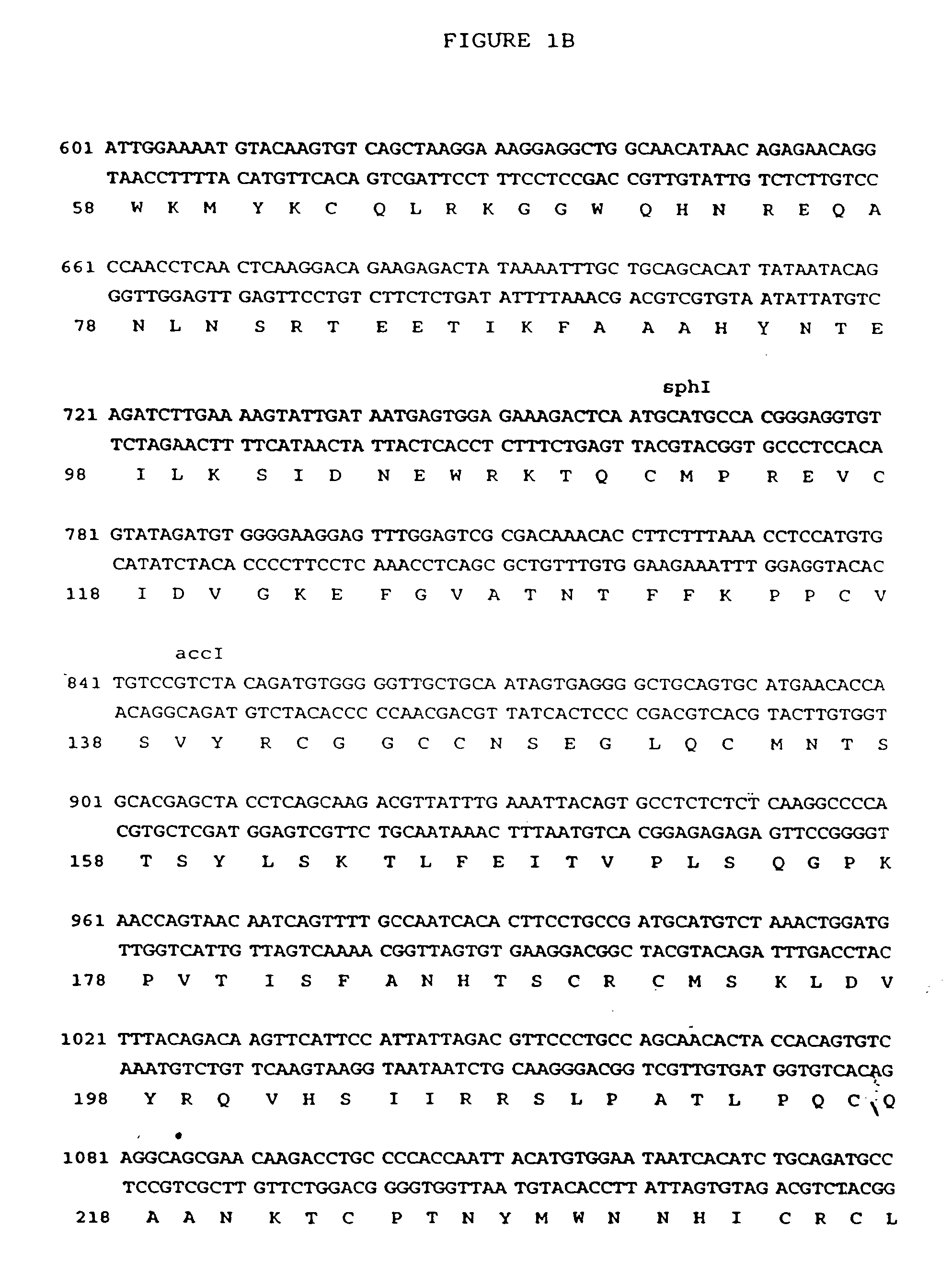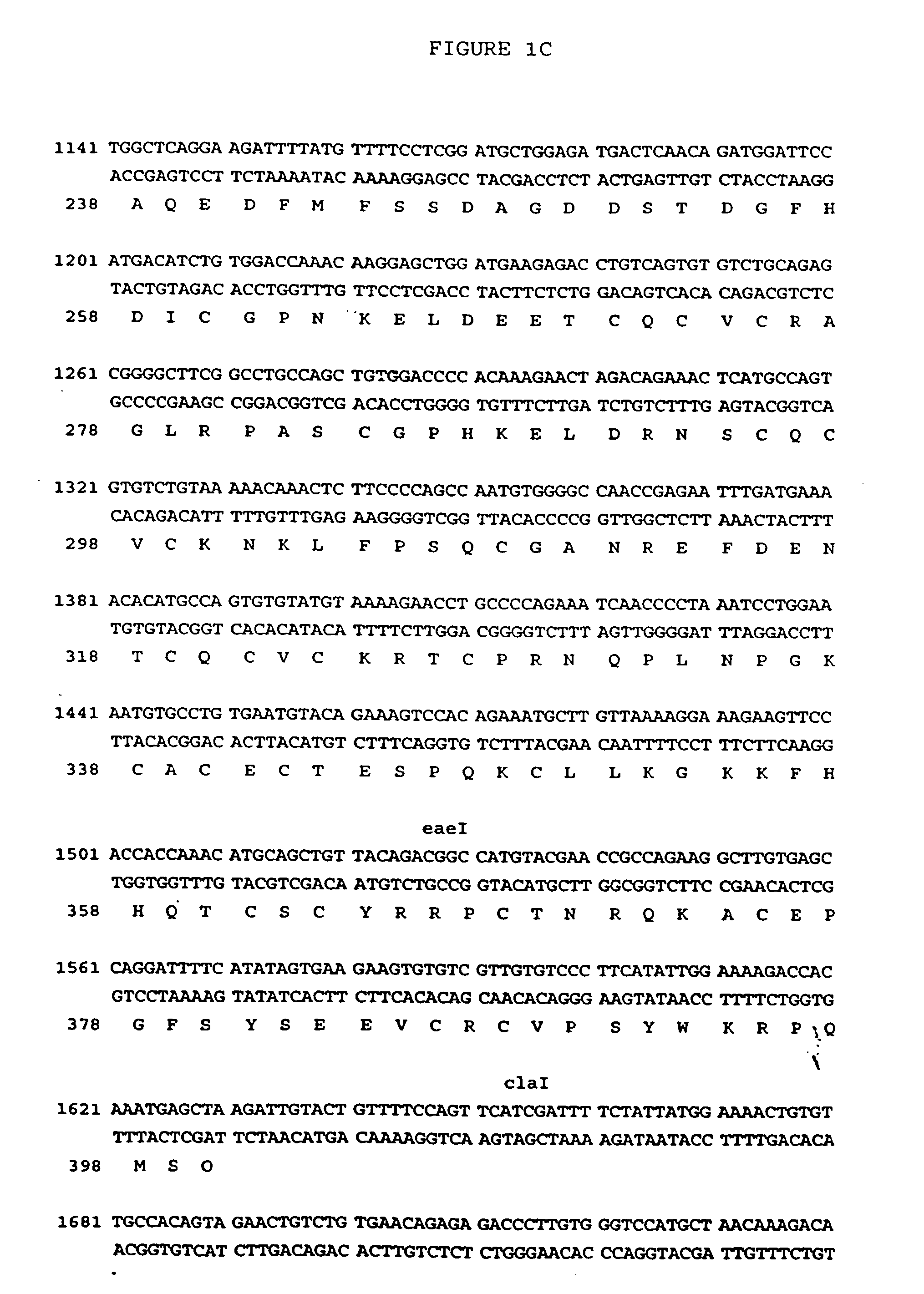VEGF-related protein
a vegf and kinase technology, applied in the direction of peptide/protein ingredients, depsipeptides, fusion polypeptides, etc., can solve the problems of loss of biological activity and possible immunogenicity changes, low product yield, and complex recovery of genomic dna encoding vrp
- Summary
- Abstract
- Description
- Claims
- Application Information
AI Technical Summary
Benefits of technology
Problems solved by technology
Method used
Image
Examples
example 2
Receptor IgG Fusion Proteins, Flt4 / IgG Antiserum, and G61 FACS Analysis
[0249] Flt1 / IgG (Park et al., supra), Flk1 / IgG (Park et al., supra), Rse / IgG (Godowski et al., Cell, 82: 355-358 [1995]), and Htk / IgG (Bennett et al., J. Biol. Chem., 269: 14211-14218 [1994]) were produced as described in these references. For Flt4 / IgG, DNA encoding the extracellular domain of the Flt4 receptor (amino acids 1-775) was spliced to the Fc region of a human IgG heavy chain at the unique BstEII site in the plasmid pBSSK-Fc (pBSSK-CH2CH3). Bennett et al., J. Biol. Chem., 266: 23060-23067 (1991). The open reading frame encoding Flt4 / IgG was cloned in the mammalian expression vector pRK5 (Suva et al., Science, 237: 893-896 [1987]) to yield the plasmid pRK5.tk1ig1.1. This plasmid was transfected by electroporation (Janssen et al., supra) into 293 cells (ATCC CRL 1651), and after 3-4 days, Flt4 / IgG was purified from the serum-free conditioned medium with protein A agarose (Calbiochem). Flt4 antiserum was g...
example 3
Isolation of cDNA Clones Encoding Human VRP
[0252] A cDNA library was prepared from polyA+RNA isolated as described in Cathala et al., DNA: 2: 329-335 (1983) and Aviv and Leder, Proc. Natl. Acad. Sci. USA, 69: 1408-1412 (1972) from the human glioma cell line, G61. Hamel et al., supra. cDNA was prepared from this RNA with reagents from GIBCO / BRL (SuperScript) and cloned in the plasmid pRK5B (Holmes et al., Science, 253: 1278-1280 [1991]) digested with XhoI and NotI. Clones encoding VRP were isolated by screening the cDNA library with synthetic oligonucleotide probes based on an EST sequence (GenBank locus HSC1WF111), which showed a reasonable match to VEGF. The EST sequence of HSC1WF111 is 299 bp and is 36% identical to VEGF over 50 residues, including an 11 of 13 residue match beginning at VEGF amino acid 56. The sequence is as follows:
1 5'- (SEQ ID NO: 6) CCGTCTACAGATGTGGGGGTTGCTGCAA-TAGTGAGGGGCTGCAGTGCATG AACACCAGCACGAGCTACCTCAGNAAGACGTTATT-TGAAATTACAGTGCC TCTCTCTCAAGGCCCCAAACCAGTA...
example 4
Receptor IgG Precipitation of .sup.35S-Labeled VRP
[0260] To determine whether VRP is a ligand for Flt4, expression plasmids containing the VH1.4 cDNA clone, as well as control plasmids (the expression vector alone or with VEGF or PlGF DNA), were transfected into COS7 cells and the proteins labeled with .sup.35S amino acids. Conditioned media from these cells was precipatated with Flt4 / IgG and Flk1 / IgG. Specifically, the VRP expression plasmid, pRK.vh1.4.2, was constructed by deleting about 360 bp of 5' untranslated sequence (5' of the AgeI site (FIG. 3A) from VH1.4). This DNA and control plasmids encoding VEGF.sub.165 (Houck et al., Mol. Endocrinol., 5: 1806-1814 [1991]), PlGF.sub.152 (Park et al., supra), or the vector alone (pRK5; Suva et al., supra) were transfected into COS7 cells with DEAE-dextran. Janssen et al., supra. Two days after transfection, the cells were pulse-labeled in 10-cm dishes for 5 hours with 5 mL of methionine- and cysteine-free DMEM supplemented with 100 .mu...
PUM
| Property | Measurement | Unit |
|---|---|---|
| molecular weight | aaaaa | aaaaa |
| concentration | aaaaa | aaaaa |
| concentrations | aaaaa | aaaaa |
Abstract
Description
Claims
Application Information
 Login to View More
Login to View More - R&D Engineer
- R&D Manager
- IP Professional
- Industry Leading Data Capabilities
- Powerful AI technology
- Patent DNA Extraction
Browse by: Latest US Patents, China's latest patents, Technical Efficacy Thesaurus, Application Domain, Technology Topic, Popular Technical Reports.
© 2024 PatSnap. All rights reserved.Legal|Privacy policy|Modern Slavery Act Transparency Statement|Sitemap|About US| Contact US: help@patsnap.com










